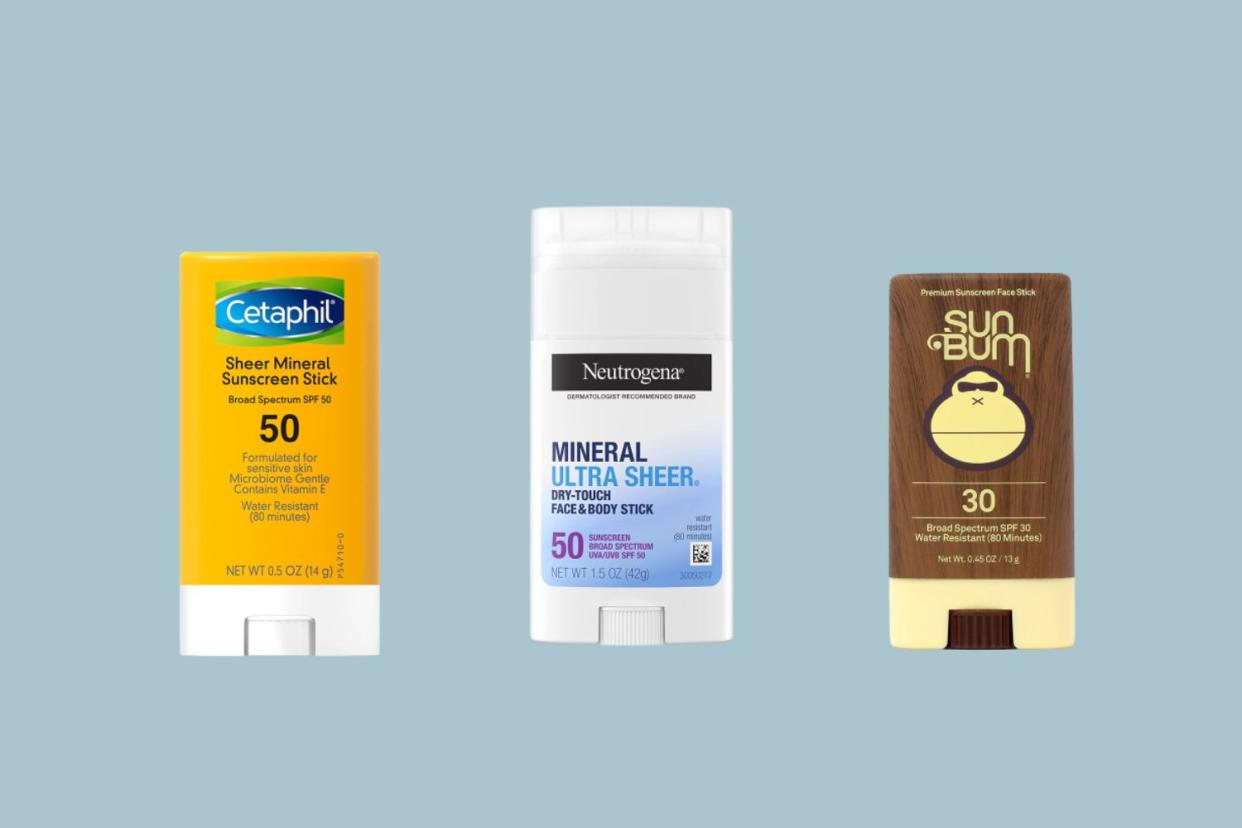How to Clean a Sunscreen Stick, According to Dermatologists

Cetaphil, Neutrogena, Sun Bum
Fact checked by Nick Blackmer
Sunscreen sticks are a form of sunscreen designed to provide sun protection for the face, including sensitive areas like the nose, cheeks, and forehead.
Experts recommend cleaning the top layer of the stick regularly since these products can harbor bacteria over time.
If you want to use a sunscreen stick, looks for options that are broad-spectrum, mineral-based, and an SPF of 30 or higher.
When it comes to protecting your skin from the sun, there are many options on the market that you can choose from—including lotions, creams, sprays, powders, and wipes.
More recently, sunscreen sticks, which resemble deodorant, have become a more popular option among consumers because of their mess-free application and portability.
According to Calvin Williams, MD, FAAD, a board-certified dermatologist and medical director of Essential Dermatology Group, in Bedford, Texas, sunscreen sticks are solid sunscreen formulations designed for easy and convenient use on the face, especially targeting sensitive areas like the nose, cheeks, and forehead.
“These products are typically best for the face due to their small size and potential for uneven coverage on larger surfaces,” Williams said. “These sticks are most effective when applied correctly and when they have an adequate sun protection factor (SPF).”
Unlike other sunscreen products like creams and sprays, sunscreen sticks need to be more frequently reapplied to the face, similar to lip balm.
Frequent reapplication means lots of contact with the dirt and oil on your face. Luckily, there’s a few simple ways to keep the stick clean.
Apply the stick directly on clean skin by gently moving the stick in a circular motion across each area of the face to ensure even coverage. Don’t forget sensitive places like the hairline, ears, and around the eyes.
Are Sunscreen Sticks Sanitary?
While sunscreen sticks can be a simple and convenient way to apply sunscreen to the face, they can harbor bacteria over time, similar to lip balms, lipsticks, and chapsticks, Williams said.
“With repeat use, facial sunscreen sticks can have bacteria buildup,” he said.
Emily Wood, MD, a board-certified dermatologist at Westlake Dermatology in Austin, Texas, told Verywell that long as the stick is kept clean and not shared with others, it should be considered hygienic.
“To be on the safe side, I recommend one stick per person for adults. With that said, parents can feel safe to use the same stick on each of their kids,” Wood said.
Teenagers, however should avoid sharing sunscreen sticks to prevent the spread of germs.
Proper use may vary from product to product. Follow the directions on a sunscreen stick’s packaging and replace the stick as recommended by the manufacturer in order to maintain its effectiveness and hygiene.
How to Clean a Sunscreen Stick
To properly clean a sunscreen stick, wipe the top layer of the stick with either rubbing alcohol or an antibacterial wipe, Wood said. This will help prevent unnecessary bacterial overgrowth and buildup on the stick.
If you don’t have rubbing alcohol or wipes, you can clean the facial stick with warm water and a clean cloth, or by using an alcohol pad, Williams added.
How often you clean your facial stick will depend on how much you use it. While you don’t have to clean it after every use, Wood said it’s generally a good idea to clean the stick after every two to three uses.
Who Should Use a Sunscreen Stick?
When it comes to sunscreen protection, choosing a product is largely dependent on your personal preferences and lifestyle circumstances, Williams said.
For example, sunscreen brushes and sticks may be a good option for those who are constantly on the go—they can make reapplication easy and convenient, especially at formal events when gracefully applying a lotion may prove difficult.
While facial sunscreen sticks can provide convenience and targeted application to hard-to-reach and sensitive areas on the face, Williams said that lotions, creams, or even sprays are more suitable for broader coverage on larger areas of the body.
Related:Do Spray Sunscreens Actually Work?
“I typically recommend using sunscreen lotions or creams over sprays, as they are notorious for uneven application or under-application,” Williams said.
Ultimately, choosing a sunscreen product comes down to finding something you’ll be willing and able to use.
“The sunscreen you will actually use is your best option. If rubbing a stick is the only method that will work for your lifestyle, then I think it is a great option,” Wood said. “Still, sunscreen sticks really have their place for kids, people on the go, and people who live an active lifestyle.”
How Can I Find the Right Sunscreen Stick for My Face?
If you decide to add a sunscreen stick to your skincare routine, look for a broad-spectrum product (which blocks UVA and UVB rays), that contains water-resistant formulations, and has an SPF of 30 or higher. Both experts recommend the following products:
Wood suggests choosing a product that is mineral based and contains ingredients like zinc oxide and/or titanium dioxide. Avoid any chemical-based sunscreen sticks, such as those with avobenzone, octisalate, or octocrylene.
“Some studies suggest that chemical formulations may have ill effects on our health and the environment,” she said.
Sunscreen sticks are a simple and convenient way to protect your skin from the sun, particularly areas on the face like the cheeks, nose, and forehead. If you decide to use a sunscreen stick on your face, experts recommend cleaning it regularly by wiping the top layer of the stick with rubbing alcohol or an antibacterial wipe to avoid unnecessary bacteria buildup.
Read Next:Asking These 7 Questions Can Make Your Sunscreen More Effective

